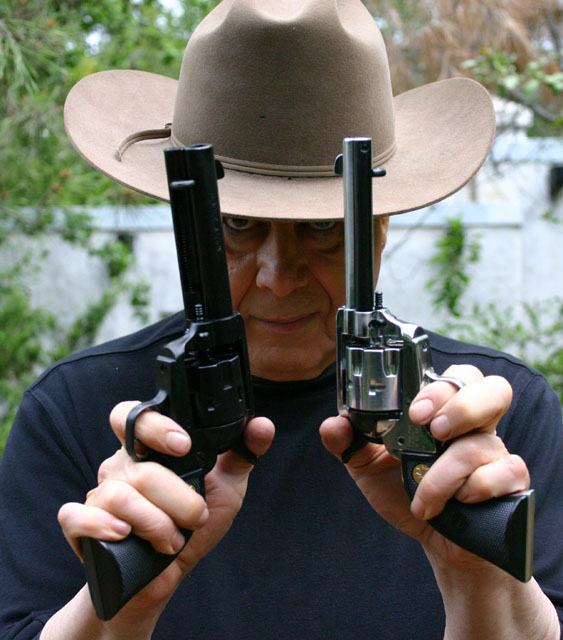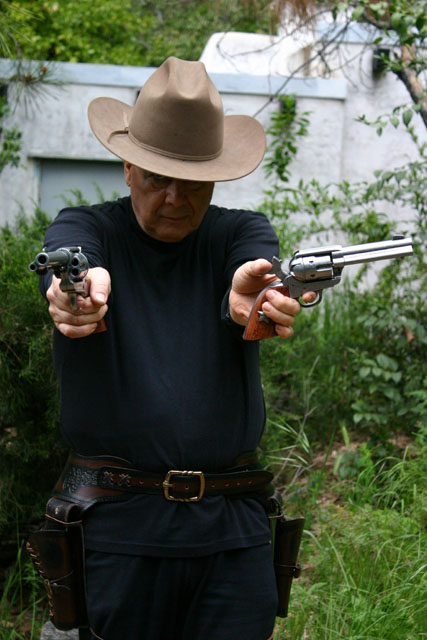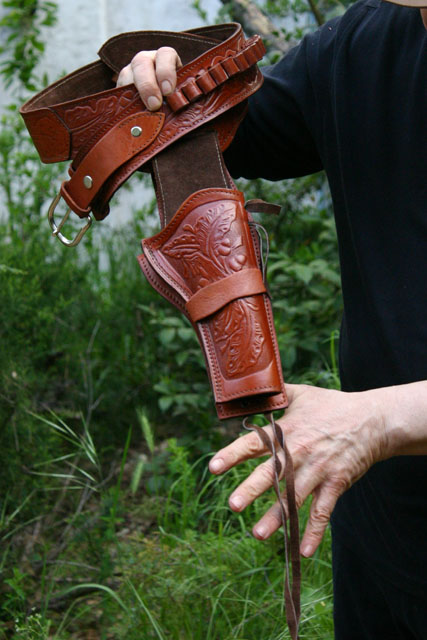
If you’re going to take the hands-on Reincarnation Awareness (RA) Program, you’ll have to pick up a gun sooner or later, realizing that no matter what your feelings and attitudes about guns might be at the moment, in the past, you carried a gun because there were no police, and the army didn’t give a damn about civilians — their attitude was that it was none of their business, anyway.
So now you have a choice, if revolver it must be. There are modern automatics, but some of them, such as the MAC 11 with Silencer, weren’t around a decade ago. Revolver it is, then — those are what we used back in the day of the Romantic Old West, except that it wasn’t at all romantic, any more than it is today. It was gritty, demanding and dangerous to live in the post Civil War period, but we managed somehow. Most of us — if you’re reading this you were one of the “us” — lived from about 1831 to 1899, and some centenarians continued to persist as living flesh as late as 1921.
A revolver has several important parts. It has a handle, on which is what is called a “grip”. It’s usually carved out of ivory, bone, hardwood or gravured gold and silver chasing.
The most important part? They all are. If one part doesn’t work, the revolver doesn’t work, and in a fire-fight, that’s deadly and generally quite final.
There’s a barrel, through which the bullet travels on its way to the target. The longer the barrel, the slightly more accurate the shot will be. You can be sure of accuracy up to about a foot away, and even then you CAN miss!
In some revolvers, you’re expected to put a cap in the back of what is called the “cylinder”, that round thing that revolves in a revolver. Then you put a charge and ball into the front of the cylinder. Sound crude? It is. It’s just one step removed from the flintlock and musket. But it can be reloaded much faster, and can be fired a number of times without stopping to reload. A second non-firing person could reload one weapon while the shooter used the other; this gave a maximum of six shots before reload, then a quick weapon-switch.
There’s a hammer, which has on its front a “firing pin” that strikes the center or rim of a cartridge, in the case of a cartridge type revolver. The hammer is released by the “trigger”, named after a famous movie horse, just like the Father of Our Country, George Washington, was named after a famous bridge.
Okay, so then what happens? In the older revolvers, there’s a Single Action. Newer revolvers tend to be Double Action.
Careful, you could get as confused and befuddled about this as I have from time to time. Here’s how you can remember which is which and which does what:
Double action means that all the work is done for you from the moment you pull the trigger; it engages the cylinder, which turns one unit, presenting a fresh cartridge to the hammer and firing pin, and the gun goes off.
Single Action means that you need to use another finger or thumb to cock the hammer all the way to full-back position. It is now ready to fire, but required two actions, cocking and trigger pull, to get the result.
Confusing, eh? Single action means two actions, and double action means one, but they’re referring to the pistol’s actions, not your hand’s action, see?
So…single action is the preferred piece; it’s older, just the right period, what they now call the “Indian Wars” of America. Many of the single-action revolvers that found their way to the Old West were brought there by recent Union and Confederate veterans who followed newspaper editor Horace Greeley’s advice in his column: “Go West, Young Man, Go West!”
And they did. By the droves. In their covered wagons, and on horseback, some, like Johnny Appleseed, who was a real person, walked all the way.

Myself, I took a stagecoach, and when they came in, setting off all those profitable range wars in the flatlands of America, I took the newfangled train. I recommended to one porter that they ought to remove the cow-catcher from the front of the steam locomotive and put it on the caboose in the rear of the train, because although we were traveling much too slowly to actually bump into a cow, there was nothing to prevent one from climbing aboard on the back.
Single action has several advantages over double action. It acts as a kind of “safety” because it makes you actually work hard to get that hammer drawn back. It’s a very deliberate move, something that generally doesn’t happen, at least not all the way back, accidentally, by brushing it lightly. It takes effort to pull the hammer on a single action revolver.
Another advantage is the same leg-up that you get with a camera. Large single-lens reflex mirror, as in the Hasselblad 6x6mm medium-format cameras, will have a loud, clumsy mirror-slap as it exposes the film and then snaps back into light-protective position. In the single-action revolver, you eliminate a lot of “slop” that comes in from the mechanism itself.
Keep in mind that a single degree off, and you miss at ten feet. You want every advantage, and the single-action gives you that.
Thirdly, if you plan to spin your revolver, even just on a return to holster, you’ll want the single action. A double action might just go off, and if you do this in the advanced course, you’ll be competing for time and accuracy with wax bullets. This can be very dangerous in a double-action revolver, and is NOT recommended. In fact, you’re strictly on your own recognizance when it comes to handling these things.
I never recommend live ammo, even “harmless wax bullets”, which are by no means harmless — they’re slightly less deadly than lead, is all — and I certainly would not recommend practicing fast-draw or gun-twirling without supervision and lessons first.
Incidentally, here’s the holster you’ll be working with at first when you come to the RA Project Workshop at the Summer Solstice Festival, June 22nd-25th, 2012:

If you can’t attend in person, you can order a replica 1877 fast-draw revolver, holster, badge and hat and use them with us. Of course, without immediate feedback and correction, bad habits could develop, but if you can’t make it here, that can be managed by having me watch a video you’ve posted on youtube.
Okay, ’nuff said; I gotta get to work on my Full 3-D Web Browser Game with our new engine and app compiler! See you at 6:30 at the ICW!

